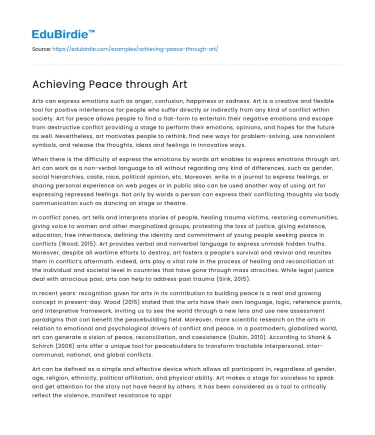Arts can express emotions such as anger, confusion, happiness or sadness. Art is a creative and flexible tool for positive interference for people who suffer directly or indirectly from any kind of conflict within society. Art for peace allows people to find a flat-form to entertain their negative emotions and escape from destructive conflict providing a stage to perform their emotions, opinions, and hopes for the future as well. Nevertheless, art motivates people to rethink, find new ways for problem-solving, use nonviolent symbols, and release the thoughts, ideas and feelings in innovative ways.
When there is the difficulty of express the emotions by words art enables to express emotions through art. Art can work as a non-verbal language to all without regarding any kind of differences, such as gender, social hierarchies, caste, race, political opinion, etc. Moreover, write in a journal to express feelings, or sharing personal experience on web pages or in public also can be used another way of using art for expressing repressed feelings. Not only by words a person can express their conflicting thoughts via body communication such as dancing on stage or theatre.
Save your time!
We can take care of your essay
- Proper editing and formatting
- Free revision, title page, and bibliography
- Flexible prices and money-back guarantee
In conflict zones, art tells and interprets stories of people, healing trauma victims, restoring communities, giving voice to women and other marginalized groups, protesting the loss of justice, giving existence, education, free inheritance, defining the identity and commitment of young people seeking peace in conflicts (Wood, 2015). Art provides verbal and nonverbal language to express unmask hidden truths. Moreover, despite all wartime efforts to destroy, art fosters a people’s survival and revival and reunites them in conflict’s aftermath. Indeed, arts play a vital role in the process of healing and reconciliation at the individual and societal level in countries that have gone through mass atrocities. While legal justice deal with atrocious past, arts can help to address past trauma (Sirik, 2015).
In recent years’ recognition given for arts in its contribution to building peace is a real and growing concept in present-day. Wood (2015) stated that the arts have their own language, logic, reference points, and interpretive framework, inviting us to see the world through a new lens and use new assessment paradigms that can benefit the peacebuilding field. Moreover, more scientific research on the arts in relation to emotional and psychological drivers of conflict and peace. In a postmodern, globalized world, art can generate a vision of peace, reconciliation, and coexistence (Dubin, 2010). According to Shank & Schirch (2008) arts offer a unique tool for peacebuilders to transform tractable interpersonal, inter-communal, national, and global conflicts.
Art can be defined as a simple and effective device which allows all participant in, regardless of gender, age, religion, ethnicity, political affiliation, and physical ability. Art makes a stage for voiceless to speak and get attention for the story not have heard by others. It has been considered as a tool to critically reflect the violence, manifest resistance to oppression, and assist in healing trauma.






 Stuck on your essay?
Stuck on your essay?

